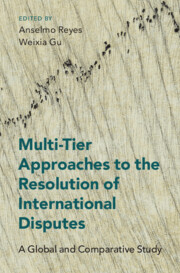Book contents
- Multi-tier Approaches to the Resolution of International Disputes
- Multi-tier Approaches to the Resolution of International Disputes
- Copyright page
- Contents
- Figures
- Tables
- Contributors
- Acknowledgements
- Table of Cases
- Table of STATUTES AND INSTRUMENTS
- Table of Rules, Codes and Guidelines
- Abbreviations
- Part I A Global Overview of Multi-tier Dispute Resolution: Main Themes
- Part II Multi-tier Dispute Resolution in Asia
- Part III Multi-tier Dispute Resolution in the Wider World
- 11 Multi-tier Commercial Dispute Resolution Processes in the United States
- 12 Multi-tiered Dispute Resolution Clauses
- 13 Multi-tier and Mixed-Method Dispute Resolution in Canada
- 14 Multi-tier Dispute Resolution in Australia
- 15 Praised, but Not Practised
- 16 Multi-tier Dispute Resolution in Russia
- 17 Multi-tier Dispute Resolution under OHADA Law
- Part IV Conclusion
- Bibliography
- Index
17 - Multi-tier Dispute Resolution under OHADA Law
from Part III - Multi-tier Dispute Resolution in the Wider World
Published online by Cambridge University Press: 09 December 2021
- Multi-tier Approaches to the Resolution of International Disputes
- Multi-tier Approaches to the Resolution of International Disputes
- Copyright page
- Contents
- Figures
- Tables
- Contributors
- Acknowledgements
- Table of Cases
- Table of STATUTES AND INSTRUMENTS
- Table of Rules, Codes and Guidelines
- Abbreviations
- Part I A Global Overview of Multi-tier Dispute Resolution: Main Themes
- Part II Multi-tier Dispute Resolution in Asia
- Part III Multi-tier Dispute Resolution in the Wider World
- 11 Multi-tier Commercial Dispute Resolution Processes in the United States
- 12 Multi-tiered Dispute Resolution Clauses
- 13 Multi-tier and Mixed-Method Dispute Resolution in Canada
- 14 Multi-tier Dispute Resolution in Australia
- 15 Praised, but Not Practised
- 16 Multi-tier Dispute Resolution in Russia
- 17 Multi-tier Dispute Resolution under OHADA Law
- Part IV Conclusion
- Bibliography
- Index
Summary
Arbitration has long been regarded as the most efficient form of adversarial dispute settlement in the OHADA region. However, it has recently come under heavy criticisms for being at times slow and expensive. Consequently, in 2017, the OHADA Council of Ministers adopted a new Uniform Act on Mediation and revised the Arbitration Rules of Procedure of the Common Court of Justice and Arbitration as well as the Uniform Act on Arbitration Law. Interestingly, these new rules allow the enforcement of multi-tier dispute resolution clauses. Although multi-tier dispute resolution clauses will likely slowly become more present in contractual agreements in the OHADA region, their enforceability faces multiple challenges, such as the combination of mediation and arbitration with the same neutral and the use by the parties of mandatory language to clearly express their intent to be bound by a multi-tiered resolution clause.
- Type
- Chapter
- Information
- Multi-Tier Approaches to the Resolution of International DisputesA Global and Comparative Study, pp. 397 - 414Publisher: Cambridge University PressPrint publication year: 2021

